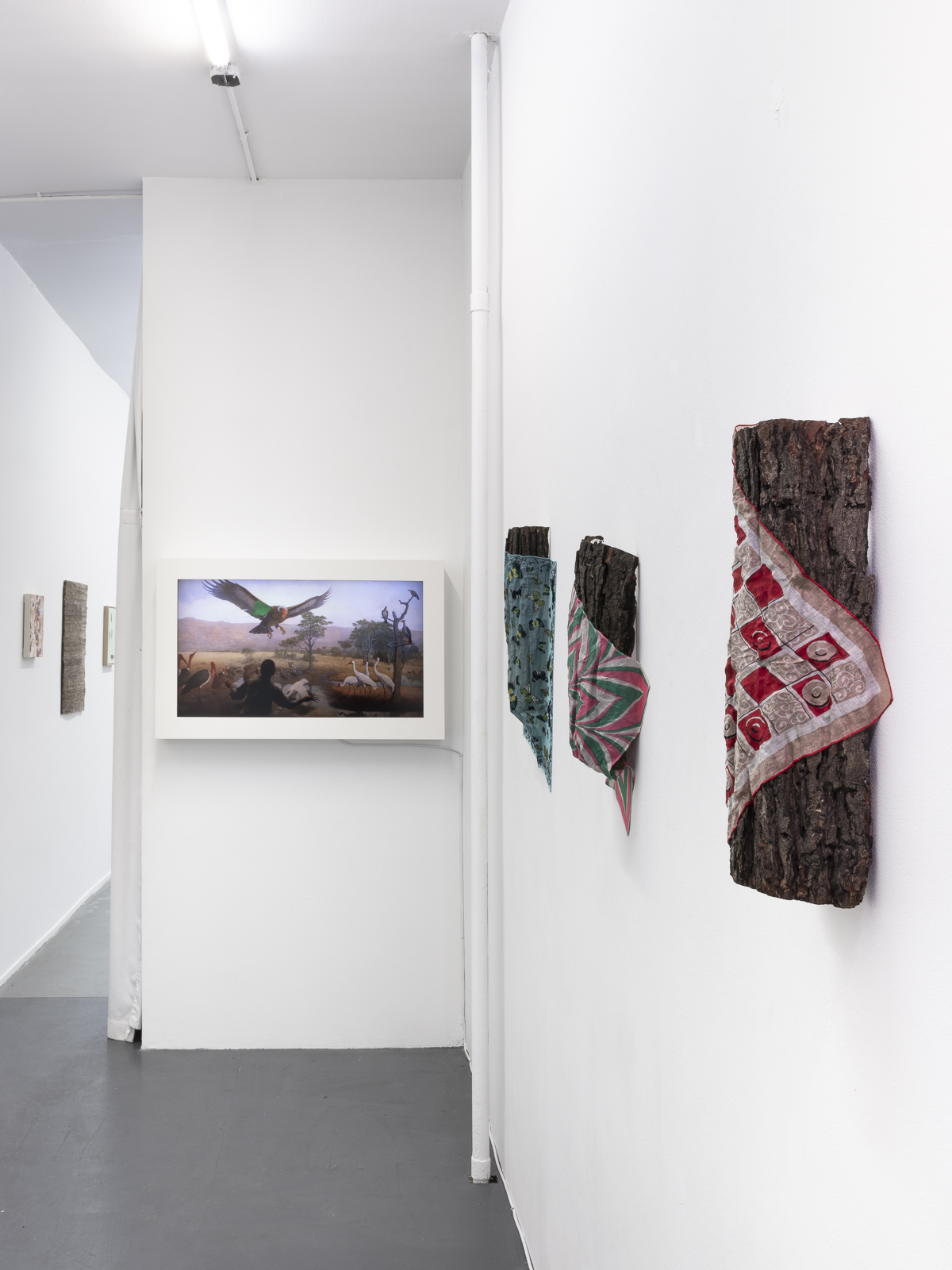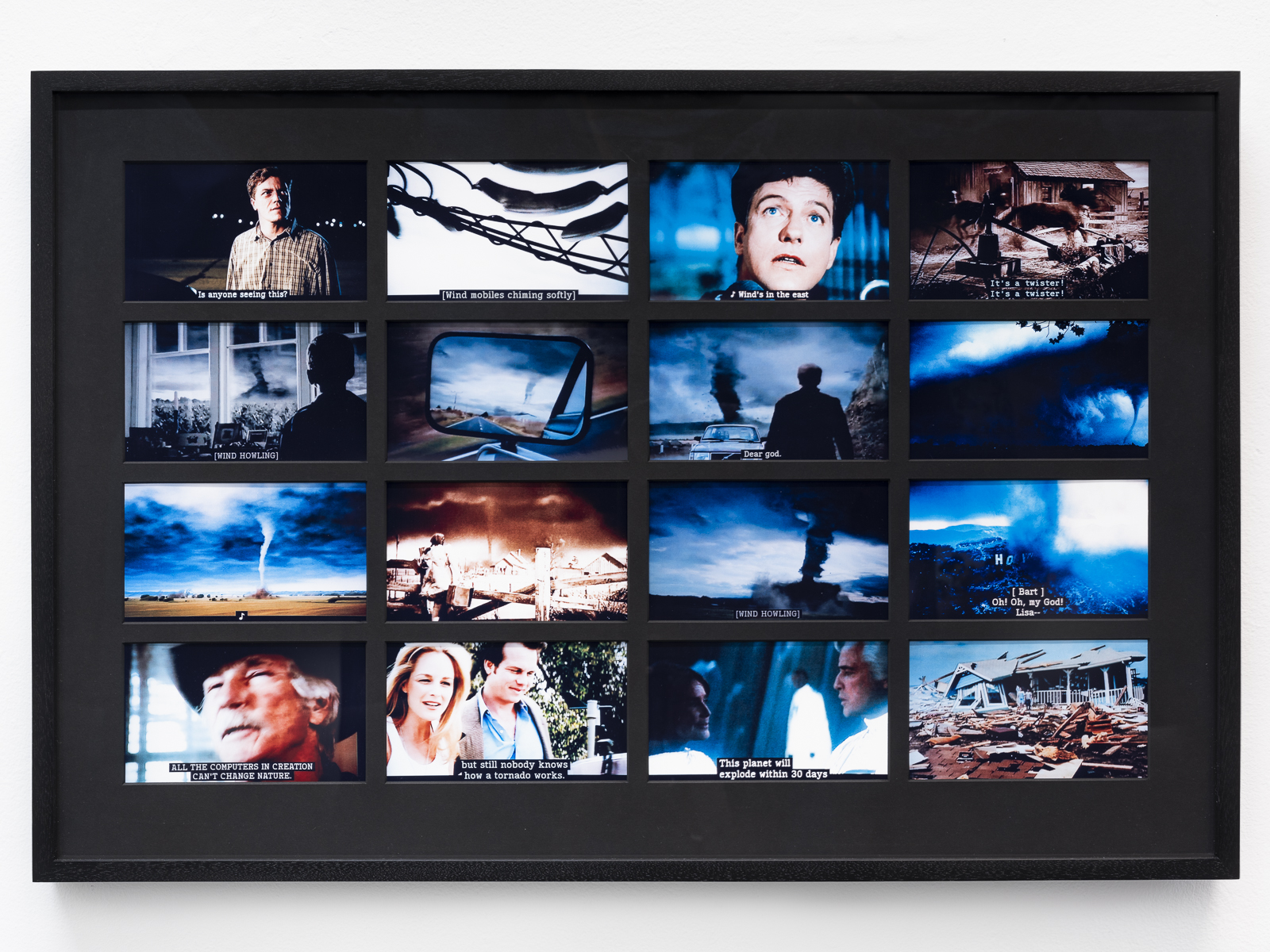DANIELE FRAZIER
Climate ControlledMarch 6 - March 28, 2021
Opening Reception: Saturday March 6, 12-6pm

Daniele Frazier, Implied Tree, Implied Wind (Red Checkers), 2021, tree bark, wood, cotton handkerchief, spar varnish, latex paint, starch, stainless steel nuts and bolts, aluminum cleat , 18 x 16 x 4 inches
Essex Flowers is pleased to present Climate Controlled, an exhibition of videos, sculptures, and photographs by Daniele Frazier.
I have spent the last decade intermittently consumed by dread; worrying about my work blowing away, impaling someone, crashing through a car windshield, ending up in the East River or the Boston Harbor, acting as a light ning rod, or getting irretrievably stuck in a tree. I panic when strong winds wake me up, whistling through the jamb of my bedroom window, conjuring images from Google searches such as, “flagpole after hurricane,” “vibration loosening bolts,” “wind uprooting tree,” and “public art that has killed people.” I own anemometers, thermometers, a stick from Vermont that tells me if it will rain, books on “Why Buildings Stand Up” and numerous volumes on kites: how to make them, why they fly. I have an account at windy.com where I drop a pin on a map and assign the minimum wind speed for which I would like to receive email notifications. I have become so intimate with this invisible entity–the collaborator in my sculptures–that in the process of understanding and working with the wind, I began considering the indoors as a place of limitations, stripped of the randomness that makes the outdoors alive and “real.” And so now, presented with the opportunity to show my work indoors, I find myself looking to reconsider the indoors as more than a climate-controlled vacuum, more than a comfortable perch from which I watch, through a window or screen, reality unfold elsewhere.
Christo said, “I love real things…Real wind, real dry, real wet, real fear, real joy.” Making something for the out doors is first-degree, confrontational. To surrender my work to the elements is to communicate, through something I made with my hands and conceived of in my mind, with a divine force—an invisible fish on the end of the line.
Since the wind itself cannot be seen, popular culture has familiarized us with stereotypes that signal its presence: an umbrella turning inside-out, a stylish headscarf worn in a convertible, a tumbleweed bumbling across a lonely road, or Superman’s cape luffing behind him heroically. But there is never no wind. Wind is fluid. It can portend disaster in the case of tornados, hurricanes, and typhoons. It can cover entire states in dust and denude whole forests. ‘Of all natural phenomena,’ says James Frazer, ‘there are, perhaps, none which civilized man feels himself more powerless to influence than the wind.’ Cinema uses the wind as a device to illustrate this existential dilemma. The intuitive characters are shown looking skyward with a dramatic air of foreboding. They foreshadow subsequent events by fixing their gaze on something trivial-yet-telling like an irregular cloud on the horizon. Authority figures, like the
President of the United States in The Day After Tomorrow, are disabled by their pride—lives are lost because they resist yielding to a force stronger than their own. The film Mary Poppins ends happily with Mr. Banks trading in his disciplined, capitalist approach to life for Ms. Poppins’s airy, enlightened ways. The profound transformation is seen as Mr. Banks, and the entire town, singing:
With tuppence for paper and strings
You can have your own set of wings
With your feet on the ground
You’re a bird in a flight
With your fist holding tight
To the string of your kite
To feel the tug on a string—Thomas Edison waiting for lightning to strike—is to communicate with a preternatural force. My sculptures do the same; they are simply elaborate kite strings.
After September 11th I staged a video using my boarding school dormitory’s ceiling fan strewn with toilet paper streamers. The video was looping footage of a tornado-like shape undulating and spinning in a messy teenage bed room. At the time, I considered it an irreverent and random gesture. In the wake of the Trump presidency and in the midst of the Covid-19 pandemic, it seems appropriate to revisit that high school piece that embodied the apocalyptic anxieties that flooded mass culture in the wake of 9/11. Creating my own tornado indoors was my first attempt at domesticating the wind.
An act of harnessing the wind is charmingly demonstrated in the movie Funny Face when Audrey Hepburn de scends the Daru staircase at the Louvre, catching the breeze of her own graceful motion by holding her red silk scarf overhead (in contrast to the flightless marble Winged Victory of Samothrace behind her) as she urgently shouts, “Take the picture! Take the picture!” Another instance of tamed atmosphere can be seen in the dioramas at the American Museum of Natural History—hermetically sealed models of otherwise wild creatures and environments. The designed state of equilibrium within the museum offers the supposedly reassuring notion of everlasting stasis— windlessness—freezing time and space like giant snow globes, at our disposal for conquering the wild on-demand with each visit or shake.
Outdoors, the taller an object, the more it must sway, like a palm tree, under the load of the wind in order not to break. This sway is known as wind drift and needs to be taken into consideration when designing something tall. For example, the original World Trade Center had a built-in wind drift of three feet at its top (occupants of the high er floors were known to get seasick at times). Outdoor art is similar to architecture (and unlike painting) in that it requires a marriage of art, technology, and the law. Before I stick a shovel in the ground, I am required to purchase general liability insurance. The otherwise boring legalese in these contracts contains an almost poetic formula for weather events beyond our control: “Acts of God.” There is now an irony to this turn of phrase, given the wealth of scientific evidence proving that anomalous weather events are traceable to human interference with the environ ment. But there is also something suggestive in it; the notion of a divine intention behind freak weather takes on new significance in the context of the detritus it leaves behind--wheat straw embedded in tree bark like blow darts, a steel beam heaved straight through a tree trunk, undamaged candles neatly embedded in plaster walls, or a flower forced into the fabric of a plank of wood--natural but unnatural artifacts reminiscent of the work of an artist.
-Daniele Frazier
--
Daniele Frazier is an artist living and working in Brooklyn, New York. Originally from Mill Valley, California, she graduated from the Cooper Union School of Art in 2007 where she received the Jacques and Natasha Gelman Trust Award. Daniele has created eight public artworks and maintains a studio where she creates smaller artworks involving photography, drawing, sculpture, and writing. Her process intersects her interest in formal aesthetics with a research-based and socially-engaged practice. She focuses on themes of ecology, climate change, natural history, art history, and social critique. Daniele’s work humorously addresses the politics inherent to public art itself such as gender inequality, the difference between public and private space, and the definition of ownership.
Daniele has worked extensively with the NYC Parks Department and her work has been shown at The Queens Mu seum, Socrates Sculpture Park, Guild & Greyshkul, Museum 52, Rivington Arms, Ritter Zamet, and Gavin Brown’s Passerby, among others.
Winds of the Northern Winter Season from Daniele Frazier on Vimeo.









